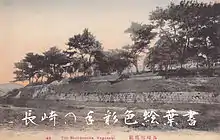| Nagasaki Gokoku Shrine | |
|---|---|
 | |
| Religion | |
| Affiliation | Shinto |
| Type | Gokoku shrine (formerly Shokonsha) |
| Year consecrated | 1869 |
| Location | |
| Location | 41-67 Joeimachi, Nagasaki, Nagasaki Prefecture |
 Shown within Japan | |
| Geographic coordinates | 32°46′41.61″N 129°51′19.59″E / 32.7782250°N 129.8554417°E |
| Website | |
| Official website | |
Nagasaki Gokoku Shrine (Japanese: 長崎護国神社) is a Gokoku Shrine located in Nagasaki, Nagasaki Prefecture, Japan.[1][2][3][4][5] It is dedicated to the spirits of the approximately 60,000 people from Nagasaki Prefecture who died from the Meiji Restoration to the Pacific War (World War II).
It is dedicated to war dead. Such shrines were made to serve to enshrine the war dead, and they were all considered "branches" of Yasukuni Shrine. They were renamed from Shokonsha in 1939.[6]
History

The shrine was founded in 1869 in the Umegasaki district of Nagasaki as the Nagasaki Shokonsha, dedicated to the 43 samurais who died in the Boshin War. In 1874, the Saku Shokon Shrine was established in the Nishi-shima district of Nagasaki to honor the 536 people who died in the Taiwan Expedition. Both shrines merged and became the Nagasaki Gokoku Shrine in 1942, with the shrine buildings being completed in 1944. Then in August 1945, all of the shrine's buildings were destroyed in the atomic bombing of Nagasaki.[7][3]: 121 The Sako Shokon Shrine (Umegasaki Tenno-miya Shrine) was temporarily located at the site of the former Sako Shokonsha. It was rebuilt in October 1963. It is designated as a National Important Cultural Property. The shrine's annual festivals are held on April 22 and October 26.
See also
- Hiroshima Gokoku Shrine
- Controversies surrounding Yasukuni Shrine
- Hero shrine
- Martial temple and Wen Wu temple
- National Revolutionary Martyrs' Shrine
- Eternal Spring Shrine
- Chinese Cultural Renaissance
- Ancestral shrine
- Gallant Garden
- Gokoku Shrines
- Tomb of the Unknown Soldier
- Arlington National Cemetery
- Valhalla (home to the souls of fallen warriors in Scandinavian mythology)
- Walhalla Shrine (a hall of fame in Germany honoring "commendable and honorable Germans")
- Eternal Spring Shrine
- The common end of myriad good deeds
- Greek hero cult
References
- ↑ "長崎で「護国神社の庭フェス」 徒歩来場者には特典も". 長崎経済新聞. Retrieved 2023-01-09.
- ↑ "長崎県護国神社 | | ながさきの平和【公式】". ながさきの平和 (in Japanese). Retrieved 2023-01-09.
- 1 2 Chinnock, Frank W. (2021-11-21). Nagasaki: The Forgotten Bomb. Routledge. ISBN 978-1-000-45899-2.
- ↑ Sturgeon, William Daniel (2006). Japan's Yasukuni Shrine: Place of Peace Or Place of Conflict? Regional Politics of History and Memory in East Asia. Universal-Publishers. ISBN 978-1-58112-334-0.
- ↑ Sturgeon, William Daniel (2006). Japan's Yasukuni Shrine: Place of Peace Or Place of Conflict? Regional Politics of History and Memory in East Asia. Universal-Publishers. ISBN 978-1-58112-334-0.
- ↑ TAKAYAMA, K. PETER (1990). "Enshrinement and Persistency of Japanese Religion". Journal of Church and State. 32 (3): 527–547. doi:10.1093/jcs/32.3.527. ISSN 0021-969X. JSTOR 23917081.
- ↑ "Hiroshima Gokoku Shrine - Hiroshima - TracesOfWar.com". www.tracesofwar.com. Retrieved 2023-11-10.
| Part of a series on |
| Shinto |
|---|
 |